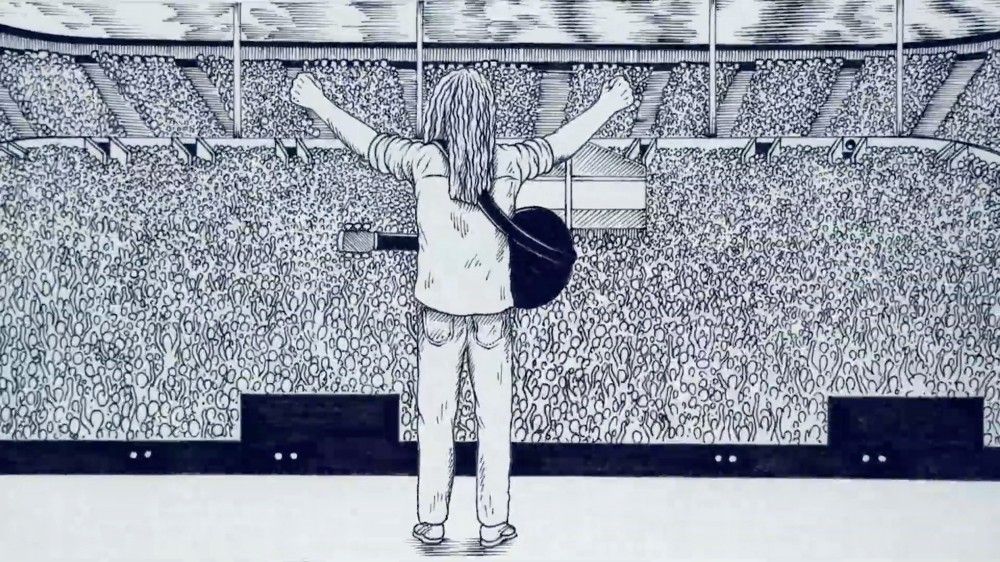
Sales of Instruments and Music Gear Are Soaring. Will Quarantine Spark a Renaissance?
In the weeks since the concert industry was stopped in its tracks, there’s been a 55% increase in Google searches for Apple’s Garageband music creation software. Apple confirms the company is seeing record levels of interest in , with nearly 13 million downloads from its add-on “Sound Library” since early February — and hundreds of thousands of free trial downloads of Garageband’s pricier siblings Logic Pro X and Final Cut Pro X.
Apogee, which makes music-creation accessories including popular iOS and Mac products like HypeMic, just experienced its most active month ever. Roland, a popular manufacturer of electronic and digital musical , equipment, and software, has seen a spike as well. Splice, which sells royalty-free samples, loops, and preset for producers, has seen more than one million sound downloads a day, the company tells Rolling Stone.
Instrument/gear seller Reverb is seeing success during this period with both new and used musical instruments — with buyers and sellers that range from large brands and local music shops to individual players and famous artists.
“We are seeing extraordinarily high order volumes, outpacing even the amount of orders we see during the busy holiday season,” says Jim Tuerk, the company’s director of business development. “Several of the music shops that sell gear on Reverb have even told us that March was one of their best months ever… Compared to this time last year, searches for music gear are up nearly 50%, with several categories — like ukuleles, MIDI Musical Instrument Digital Interface] keyboards, and drum machines — seeing search spikes of 100% or more when compared to this time last year.”
Music retailer Sweetwater has also seen a significant uptick in content and product sales from its website. Sweetwater CEO Chuck Surack tells Rolling Stone that the previous seven days were bigger than the week they had after Thanksgiving last year. Sweetwater is getting 500,000 visitors a day — around double what they’d normally see — and they’re shipping about 15-20,000 orders every day, he says.
So with such a boom in creation tools, what music is everyone making?
Never too late to learn
With time to spare, musical beginners are diving in by purchasing instruments for the first time and signing up for lessons. Tuerk says Reverb is currently welcoming an influx of new buyers. “We’re seeing an increase in acoustic , synthesizer, keyboard, and pro audio orders,” he says. “Based on the types of gear they’re purchasing, many of these new buyers appear to be beginners.”
Reverb’s YouTube channel, which largely features gear demos and how-tos, saw a notable rise in hours watched in March and April compared to January and February, which are normally the highest-trafficking months. The “Synth Sounds of” videos that demonstrate how to recreate classic synth songs saw a 300 to 400% increase in views in March.
“We’re getting about 5,000 new customers every day that are buying, and we’re getting about 15,000 people a day who are requesting catalogues and email updates,” says Surack.
Moreover, one of the top trends spotted by Guitar Center — where online sales more than doubled following the shelter-in-place mandate — shows that people are taking the opportunity to learn an instrument they have never played before, particularly one that can be learned in a quiet environment from home. Guitar Center says the entire acoustic guitar category is on fire, and ukuleles are particularly hot. They’re also seeing beginners of all ages, noting an increase in students both in the 11-to-15 age range and the above-40 group.
“Since the pivot to one-to-one online lessons with a live instructor post-pandemic, Guitar Center and its sister brand, Music & Arts, combined have taught nearly 50,000 lessons to students nationwide,” says a representative from Guitar Center. “As students have been mandated to stay indoors, many of our students are now taking more than one lesson per week. Also, for those currently participating in lessons, weekly attendance has increased as well. For kids who normally have band classes in school, online lessons is allowing them to keep up and expand their skills with their instrument.”
Registrations for Roland’s live online product training sessions, Roland Cloud Academy have far surpassed session capacity, resulting in Roland adding more courses and expanding the products covered to meet demand. The free program helps all levels of musicians get personalized live instruction from Roland’s product experts in small online classrooms of 10 to 15 students per class.
Finding the beat
In terms of year-over-year searches on Reverb, MIDI keyboard searches are up 171%, while searches for drum machines and MIDI controllers are up 125% and 117%, respectively.
“Based on what is selling on Reverb, it appears that people are making electronic music and experimenting with beats,” says Tuerk. “Compared to this time last year, we’re seeing a significant increase in synthesizer, keyboard, and beat production equipment purchases — particularly among new buyers.” Meanwhile, at Roland, downloads are up more than five times for the company’s music creation app, Zenbeats.
On Splice, even with record activity, the top five genres remain, in descending order: hip-hop, trap, pop, R&B, and house. But just after those rankings is where the company has seen interesting genre trends emerge: EDM (or “mainstream commercial electronic dance music,” says the company, referring to the likes of DVBBS, Martin Garrix, Hardwell), Downtempo, Cinematic and Funk have all seen an uptick in overall downloads.
Murda Beatz, a multiplatinum producer for Drake and Migos, recently created his first-ever digital drumkit, called “Quarantine Pack, Vol. 1,” for Splice. That quickly became the fastest pack in Splice history to cross the 1 million-download threshold, doing so in 15 days. (The previous record holder was another Drake collaborator Boi-1da, who’s also produced for the likes of Eminem and Rihanna.)
“As creative consumers continue to stay home, they’re investing in gear for their home-rigs and studios — mics, speakers, audio interfaces, music-making software, and more. Searches for audio interfaces are up 303% year-over-year.” — Jim Tuerk, Reverb’s business development director
Complexity, dear Watson
Purchases of expensive, multi-faceted gear may suggest a rise in the complexity of music that people are creating nowadays.
“Drum machines and sequencers are greatly outselling live percussion instruments, which isn’t what we typically see,” says Tuerk. “In particular, we saw a significant increase in Elektron orders — specifically the Digitone polyphonic digital synthesizer and the Digitakt digital drum computer & sampler — compared to the month prior and this time last year. Elektron synthesizers and drum machines are typically used to make serious electronic music. They’re intricate pieces of gear and require more time to master, so the increase in Elektron orders leads me to believe that people are making more complex music at home.”
The Reverb team has been seeing an increase in professional audio orders — particularly among people who’ve traditionally purchased guitar or drum gear on their site in the past. In other words, they’re seeing players that they can assume are guitarists or drummers purchasing their first audio interface, microphone, or desktop synthesizer, among other pro audio gear.
“This could indicate that they’re experimenting or that they’re trying to collaborate with other musicians virtually,” explains Tuerk. “As creative consumers continue to stay home, they’re investing in gear for their home-rigs and studios — mics, speakers, audio interfaces, music-making software, and more. Searches for audio interfaces are up 303% year-over-year.” With extra time on their hands, musicians are faced with an opportunity to step up their game.
Surack highlights a similar situation at Sweetwater, where they’re selling audio interfaces “like crazy.” “These people are also buying microphones, they’re buying headphones, speakers — everything you need to record into or digitize into your computer, complete little studios,” he says.
“I can also tell that people are upgrading their studios,” he continues. “They’re buying a whole set of drum heads to replace every one on their kit. Someone who’s bought a bunch of guitar stuff is buying new tuners, new strings, polish for the neck, and a whole bunch of other things. You can just tell that they’re taking the time to take their guitar apart, upgrade it, hot rod it, and make it new again. It’s been fun to watch that stuff as I physically pack the boxes in our warehouse] myself.”
Guitar Center is also witnessing massive growth in DJ controllers. And they’ve noticed that “many musicians who may usually record in the big studios, or DJ at clubs and festivals, have had to purchase gear to continue working on their projects at home,” a representative adds. “DJ controllers are trending big because of the live-streaming phenomenon that’s taking place on Instagram (ei: DJ D-NICE and Questlove).”
Distant and more collaborative than ever
Being physically forced apart hasn’t stopped people from banding together. A lack of socializing could even be inspiring more collaboration as people feel a need to interact.
Collage-style videos that compile clips of different musicians tackling different parts of the same song have begun to bubble up more frequently. Arranger David Wise and mix engineer Garth Justice, for example, released a video, called the Nashville Studio Singer Community Virtual Cell Phone Choir, that has since accumulated more than a million views. All the vocals were recorded individually by each of the 31 local professionals on their iPhones and then submitted to Wise and Justice. Justice, who says everything he buys comes from Sweetwater, used two plug-ins, the iZotope RX Suite and Oeksound’s Soothe, to minimize room noise and focus on certain frequencies, respectively. The result is an uplifting, hope-filled piece of art.
Last week, a video was posted that was created by students and Apple Distinguished Educator teachers from a school in the U.K. Apple says that the video was made in support of the country’s National Health Service. It’s a cover of Snow Patrol’s ”Run” — performed and captured using Garageband, Logic Pro, Final Cut Pro, Keynote, and iPhones. The lead singer recorded into Garageband using a USB microphone.
Getting weird
It seems some people, tired of routine, are getting to a point of restlessness that inspires them to think out of the box. Instrument and software sellers say they’ve seen some unusual sales, suggesting musical experimentation.
“We sold a toy telephone that had been turned into a microphone,” says Reverb. “It was converted to have a ¼” output and a gain circuit to make lo-fi sounds — think similar to the vocal sound of The Strokes. While it’s not uncommon to see a toy or something similar turned into a piece of gear by an electronics whiz, it was funny to imagine a musician using the toy telephone mic while collaborating video conference.”
“As for artists, we are all watching the YouTube videos artists are producing and enjoying all of the different genres and creations artists are making during this quarantine period,” says the rep from Guitar Center. “The biggest trend that is happening is people’s interest in making music is expanding and growing. They’re experimenting, trying new things and sharing their creations with the world in digital formats like YouTube, Instagram and TikTok.”
While the overall global economy is struggling to shake off negative effects, instrument and software sellers are finding themselves facing a new opportunity — to not only shine in the era of quarantine, but to build new momentum and promote creative productivity post-quarantine.



